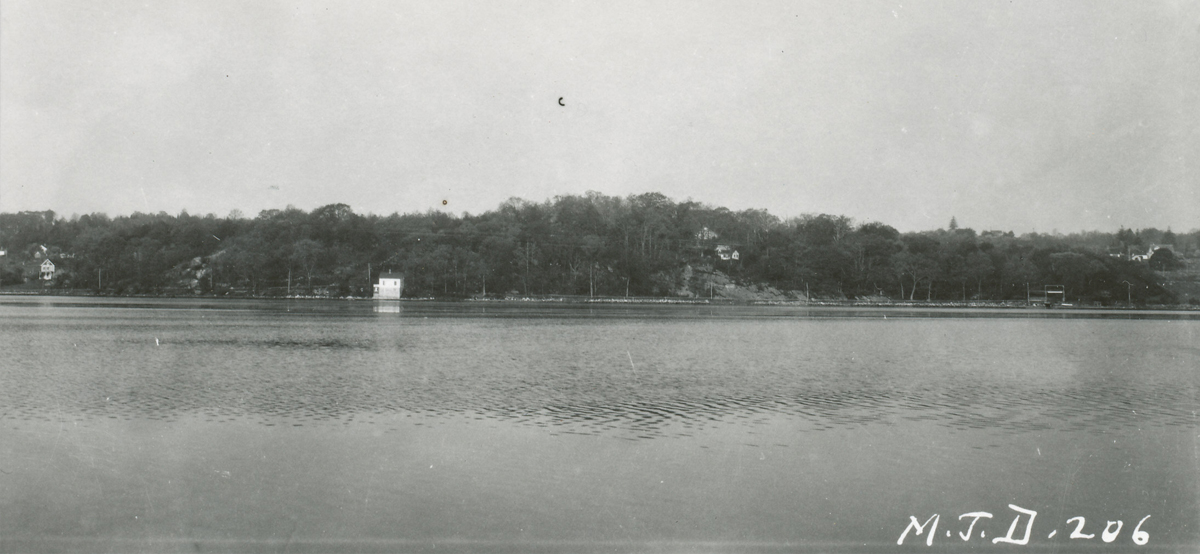Exploring other views by the river
STATION 4 of the GREENMANVILLE SELF-GUIDED TOUR

Our tour picks up the threads of Greenmanville beyond the Stillman Mansion foundation, down the south side of the main farm loop and back to the Avery Farmhouse where we began. From here, we’ll explore outside the boundaries of Coogan Farm following the Mystic River along Greenmanville Avenue to the Mystic River Boathouse Park. Please use the crosswalk located across from Sea View Snack Bar to reach the sidewalk on the river side leading to the rest of Greenmanville.
In 1894, the Mystic Industrial Company incorporated in an effort to bring more manufacturing to Greenmanville, after Congress passed the Tariff Act of 1890 substantially increasing the tax on imported goods. Funds were raised, land was given near the old Greenmanville store and a building erected in 1898. It was subsequently leased to the Rossie brothers of Süchteln, Germany, for a velvet mill. The Rossie Bros. Velvet Company would later become the largest employer in Mystic, bring further diversity of culture to Greenmanville.
The remnants of the velvet mill still exist today, with the large brick building housing the Collections & Research Center at Mystic Seaport Museum on the east side of Greenmanville Avenue as well as on the river side at the fenced site surrounding a small point of land being redeveloped into the Mystic River Boathouse Park. The public will soon enjoy access to a waterfront park here, as well as access to a view of the west side of the river where significant stories of land and people rooted in conflict and peace have transpired.
In the late 19th-century and early 20th-century, the landscape known as Great Hill on Groton bank (across the river from Mystic Seaport Museum and the Mystic River Boathouse Park) was home to the Universal Peace Union and their annual summertime peace conventions. Well-known abolitionists, suffragists and orators of the time spoke at the peace meetings and held lectures in the arts and sciences.
Frances Ellen Watkins Harper, a poet, feminist and anti-slavery lecturer from Philadelphia, addressed a crowd at the Peace Grove in 1901 on the topic of lynchings. While we do not know what she said that day, her words a year prior to her Mystic visit resonate today:
“When ye plead for the wrecked and fallen,
The exile from far-distant shores,
Remember that men are still wasting,
Life’s crimson around your own doors.
Have ye not, oh, my favored sisters,
Just a plea, a prayer or a tear,
For mothers who dwell ‘neath the shadows,
Of agony, hatred and fear?”
Passage from An Appeal to My Countrywomen, Frances Harper, 1900
In 1914, outdoor enthusiast, explorer and author Mary L. Jobe (Akeley) purchased the Great Hill acreage and established a summer camp for girls called Camp Mystic. Operating until the Great Depression, Camp Mystic was a place of learning and fellowship. After Akeley’s passing, a trust and sanctuary were established, and today the land remains under the stewardship of Denison Pequotsepos Nature Center.
Three hundred years prior to Camp Mystic, the view of that same hill was a place of homeland and harvest situated along a valley rich with life and possibility for the Pequot Nation. It would eventually turn to crimson at their village threshold, just beyond Pequot Hill. Places have different meaning for different people and no particular people can really own the story of a place. The landscape here on the westward side of the Mystic River is a place of peace and fellowship and a place of conflict and bloodshed. What do you see when your gaze meets this place?
Share the Greenmanville Trail web tour!

Pictured above: (Top left) Photograph showing the Peace Grove in August 1894, Stonington Historical Society. (Bottom right) Universal Peace Union program from August 1901, Mystic River Historical Society. (Bottom left) Campers from Camp Mystic canoeing on Mystic River. (Top right) View of the river’s west bank and Camp Mystic in 1930 from the Josephine Dickinson Collection. Both photographs are from the Mystic River Historical Society.


